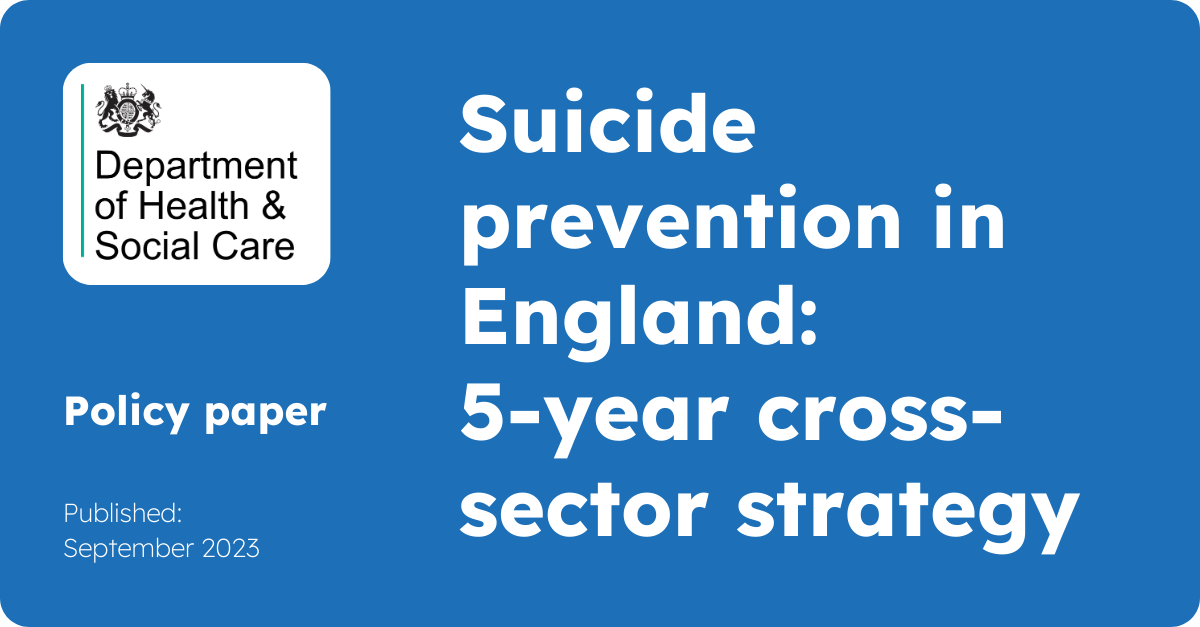Our reflections on the latest five year cross-sector strategy for suicide prevention in England

September 15 2023
“Suicide is everyone’s business and everyone has a role to play in suicide prevention.” Maria Caulfield MP, Minister for Mental Health and Women’s Health
It has been 11 years since the last suicide prevention strategy was published in England and while overall the current suicide rate is not significantly higher than in 2012, the rate is not falling. That is not to say that considerable strides forward haven’t been made, but this strategy makes it clear that momentum towards reducing the number of deaths by suicide must remain strong.
The new strategy, published by the Department of Health and Social Care (DHSC), is far reaching – setting out over 100 actions and priorities for government departments, the NHS, the voluntary sector and other national partners to address, particularly over the next two years. Three core aims the DHSC looks to impact are simple and clear:
- reduce suicide rates
- improve support for people who have self-harmed
- improve support for people bereaved by suicide
It is a welcome refresh of prevention strategies that use a holistic approach to lessen death by suicide and its wider impact. We agree that providing resources and support systems early at a population level will help to catch people before reaching a point of crisis. Working with partners who have robust clinical frameworks in place will be critical to safely managing risk within these population wide systems.
“From our experience at Togetherall, we know that when people anonymously have access to 24/7 clinically moderated online support they can share and potentially get help for issues before problems arise. For people who are at risk online, including relating to suicide, services that effectively provide moderation that is also backed up by robust crisis escalation procedures can save lives. Togetherall’s peer support community is there every hour of every day to help people support each other, whatever their mental health issues are. When used as part of a robust system of moderation and risk management, online digital platforms can play a crucial role in the prevention of suicide” Dr Tim Rogers, Clinical Director, Togetherall
Specific consideration within the strategy has been focused towards harnessing the power of online platforms and technology, including the effectiveness of peer support. Connecting with a community of people who share lived experiences and can exchange words of advice, support and guidance is vital to normalise difficult feelings and foster a sense of belonging. Delivering peer support in a digital setting helps reach those who would not otherwise connect with in-person or one-to-one services. It is encouraging to see the DHSC set out ambitions to widen access to digital support services and prioritise the assessment of and learning about these technologies.
Within this strategy, particular attention has been given to priority groups who are identified as at higher risk of suicide such as men and younger people. The DHSC has outlined several ambitions to incorporate into service design for these priority groups. As part of Togetherall’s intention to better support men’s mental health, in 2021, we partnered with men’s health charity, Movember, who are remodelling men’s health research and transforming the way health services reach and support men. The partnership has informed the way we communicate with men, from explaining how Togetherall can help them, to their journey within our platform. Our understanding of supporting men tells us that stigma, access and service design have a big impact on the effectiveness of a support system. Since three out of four deaths by suicide in the UK are men, specific national objectives for this demographic are vital if the DHSC are to achieve the overall aim of reducing the number of people who die by suicide in the next 5 years.
Another significant priority group identified by the DHSC is young people. Providing the right support and environment in educational institutions is an integral part of suicide prevention. There are several key expectations set for this priority group, led by the Department of Education (DfE). Since launch, we have supported over 230,000 students globally and from December 2021 to date, we have managed over 500 instances of student member risk on our platform worldwide. Our window into the student mental health space from working with 165+ higher and further education providers in the UK tells us that increased focus, funding and support from the DHSC towards the next generation is much needed. But, with stretched resources at institutions, it remains to be seen if these targets can be turned into reality with pressure already on existing provisions. Education providers may need to look at complementary solutions to manage rising demand.
“Online digital platforms are an effective part of a package of integrated care for students. Having access to support when they want it and need it is part of an important duty of care for Universities and Colleges and when integrated into other student services the impact is stronger.” Emily Bromiley, Head of Partnerships and Growth, UK, Togetherall
Following publication of this latest suicide prevention strategy, the DHSC will work closely with the National Suicide Prevention Strategy Advisory Group (NSPSAG) to develop the implementation plan and establish governance processes to ensure accountability of delivery. Ultimately, there is an ambition that there is no wrong door, which includes access to digital support services online – when people experiencing suicidal thoughts or feelings reach out for help, they should be able to receive the support and services they need no matter what access route, location or mode they chose. Collaboration, connectedness and communication are key drivers of suicide prevention.
We at Togetherall continually strive to support the improvement of people’s mental health and welcome further discussions on how to work in partnership with Government and others to help achieve this.





